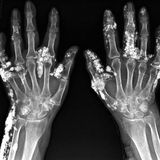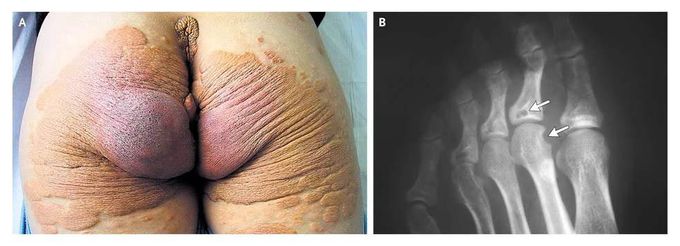


Familial Hypercholesterolemia
An 18-year-old woman with familial hypercholesterolemia presented with a 4-year history of swelling and pain in the joints. She was born with multiple xanthomas, which grew in size as she aged. Her elder brother had had more severe xanthomatosis and had died of myocardial infarction at 30 years of age. Physical examination revealed diffuse, flat xanthomas on her elbows, knees, and buttocks and large tuberous xanthomas on her buttocks (Panel A). The joints of her hands and feet were enlarged. Laboratory tests revealed the following lipid concentrations: total cholesterol, 669 mg per deciliter (17.3 mmol per liter) (normal range, 120 to 220 [3.1 to 5.7]), and low-density lipoprotein (LDL) cholesterol, 338 mg per deciliter (8.7 mmol per liter) (normal range, 0 to 131 [0.0 to 3.4]); the total triglyceride and high-density lipoprotein cholesterol levels were within the normal ranges. Radiography showed cystic and erosive lesions of the left metatarsophalangeal joints (Panel B, arrows). Evaluation did not reveal typical causes of the arthropathy, such as infection. The patient was treated with simvastatin and acetaminophen. One month later, the arthritis had improved, the total and LDL cholesterol levels had decreased to 333 and 258 mg per deciliter (8.6 and 6.7 mmol per liter), respectively, and the xanthomas were unchanged. These findings are consistent with a rare erosive arthropathy from hyperlipidemia. Sheng Guang Li, M.D. Chinese People's Liberation Army General Hospital, Beijing 100853, China source: nejm.org


